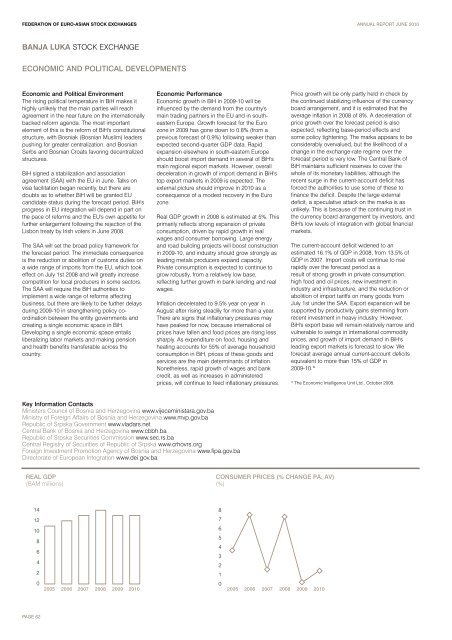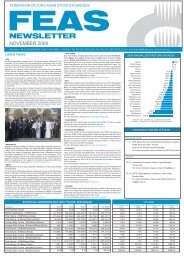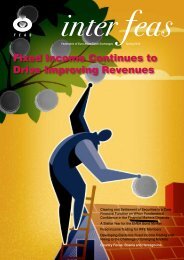Download - FEAS
Download - FEAS
Download - FEAS
- No tags were found...
Create successful ePaper yourself
Turn your PDF publications into a flip-book with our unique Google optimized e-Paper software.
FEDERATION OF EURO-ASIAN STOCK EXCHANGES ANNUAL REPORT JUNE 2010BANJA LUKA STOCK EXCHANGEECONOMIC AND POLITICAL DEVELOPMENTSEconomic and Political EnvironmentThe rising political temperature in BiH makes ithighly unlikely that the main parties will reachagreement in the near future on the internationallybacked reform agenda. The most importantelement of this is the reform of BiH's constitutionalstructure, with Bosniak (Bosnian Muslim) leaderspushing for greater centralization, and BosnianSerbs and Bosnian Croats favoring decentralizedstructures.BiH signed a stabilization and associationagreement (SAA) with the EU in June. Talks onvisa facilitation began recently, but there aredoubts as to whether BiH will be granted EUcandidate status during the forecast period. BiH'sprogress in EU integration will depend in part onthe pace of reforms and the EU's own appetite forfurther enlargement following the rejection of theLisbon treaty by Irish voters in June 2008.The SAA will set the broad policy framework forthe forecast period. The immediate consequenceis the reduction or abolition of customs duties ona wide range of imports from the EU, which tookeffect on July 1st 2008 and will greatly increasecompetition for local producers in some sectors.The SAA will require the BiH authorities toimplement a wide range of reforms affectingbusiness, but there are likely to be further delaysduring 2009-10 in strengthening policy coordinationbetween the entity governments andcreating a single economic space in BiH.Developing a single economic space entailsliberalizing labor markets and making pensionand health benefits transferable across thecountry.Economic PerformanceEconomic growth in BiH in 2009-10 will beinfluenced by the demand from the country'smain trading partners in the EU and in southeasternEurope. Growth forecast for the Eurozone in 2009 has gone down to 0.8% (from aprevious forecast of 0.9%) following weaker thanexpected second-quarter GDP data. Rapidexpansion elsewhere in south-eastern Europeshould boost import demand in several of BiH'smain regional export markets. However, overalldeceleration in growth of import demand in BiH'stop export markets in 2009 is expected. Theexternal picture should improve in 2010 as aconsequence of a modest recovery in the Eurozone.Real GDP growth in 2008 is estimated at 5%. Thisprimarily reflects strong expansion of privateconsumption, driven by rapid growth in realwages and consumer borrowing. Large energyand road building projects will boost constructionin 2009-10, and industry should grow strongly asleading metals producers expand capacity.Private consumption is expected to continue togrow robustly, from a relatively low base,reflecting further growth in bank lending and realwages.Inflation decelerated to 9.5% year on year inAugust after rising steadily for more than a year.There are signs that inflationary pressures mayhave peaked for now, because international oilprices have fallen and food prices are rising lesssharply. As expenditure on food, housing andheating accounts for 55% of average householdconsumption in BiH, prices of these goods andservices are the main determinants of inflation.Nonetheless, rapid growth of wages and bankcredit, as well as increases in administeredprices, will continue to feed inflationary pressures.Price growth will be only partly held in check bythe continued stabilizing influence of the currencyboard arrangement, and it is estimated that theaverage inflation in 2008 of 8%. A deceleration ofprice growth over the forecast period is alsoexpected, reflecting base-period effects andsome policy tightening. The marka appears to beconsiderably overvalued, but the likelihood of achange in the exchange-rate regime over theforecast period is very low. The Central Bank ofBiH maintains sufficient reserves to cover thewhole of its monetary liabilities, although therecent surge in the current-account deficit hasforced the authorities to use some of these tofinance the deficit. Despite the large externaldeficit, a speculative attack on the marka is asunlikely. This is because of the continuing trust inthe currency board arrangement by investors, andBiH's low levels of integration with global financialmarkets.The current-account deficit widened to anestimated 16.1% of GDP in 2008, from 13.5% ofGDP in 2007. Import costs will continue to riserapidly over the forecast period as aresult of strong growth in private consumption,high food and oil prices, new investment inindustry and infrastructure, and the reduction orabolition of import tariffs on many goods fromJuly 1st under the SAA. Export expansion will besupported by productivity gains stemming fromrecent investment in heavy industry. However,BiH's export base will remain relatively narrow andvulnerable to swings in international commodityprices, and growth of import demand in BiH'sleading export markets is forecast to slow. Weforecast average annual current-account deficitsequivalent to more than 15% of GDP in2009-10.** The Economic Intelligence Unit Ltd., October 2008.Key Information ContactsMinisters Council of Bosnia and Herzegovina www.vijeceministara.gov.baMinistry of Foreign Affairs of Bosnia and Herzegovina www.mvp.gov.baRepublic of Srpska Government www.vladars.netCentral Bank of Bosnia and Herzegovina www.cbbh.baRepublic of Srpska Securities Commission www.sec.rs.baCentral Registry of Securities of Republic of Srpska www.crhovrs.orgForeign Investment Promotion Agency of Bosnia and Herzegovina www.fipa.gov.baDirectorate of European Integration www.dei.gov.baREAL GDP(BAM millions)CONSUMER PRICES (% CHANGE PA; AV)(%)148127106854634221002005 2006 2007 2008 2009 2010 2005 2006 2007 2008 2009 2010PAGE 62
















